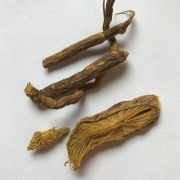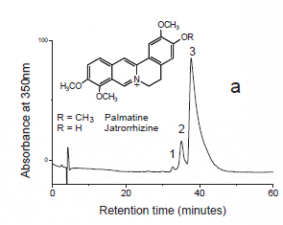Huangteng (Fibrurea tinctoria Lour.) LC
Description
Huangteng (Fibrurea tinctoria Lour.) is a large woody climber that can grow to 40 m long and a stem diameter up to 5 cm. They usually grow in lowland forest. F. tinctoria is extensively distributed from northeastern India and the Nicobar Islands, through Burma, Thailand and Vietnam east to China, and south to Malaysia, Borneo, Indonesia and The Philippines [1].
The bright yellow woody stems and roots are cut into sections for usage.
Historical Importance
In the 19th century China, haungteng was supplied to silk dyers in Canton from Guangxi province. F. tinctorua has been recorded as an important soucre of yellow dyes for all the forest-dwelling people from the eastern Himalayas to the Indonesian islands [2].
Huangteng has been reported as the dyeing source of a light yellow Chinese shawl collected in the Peabody-Essex Museum in Salem [3].
Summary of results
The major components of the plant are protoberberine alkaloids: palmatine and jatrorrhizine.
Analytical instrumentation and procedures
HPLC-DAD-MS analysis was performed with an Agilent 1100 liquid chromatography system consisting of an automatic injector, a gradient pump, a HP series 1100 DAD, and an Agilent series 1100 VL on-line atmospheric pressure ionization electrospray ionization mass spectrometer. Separations were done on a Vydac 214TP52 analytical column (2.1 mm diameterX250 mm; 5-ím particle size). The column was eluted at a flow rate of 0.2 mL/min with a tertiary gradient of water (A),acetonitrile (B), and 1% (v/v) aqueous formic acid (C) with the following elution program: 0 min, 90% A, 5% B, 5% C; 0-55 min, a linear gradient to 35% A, 60% B, 5% C; 55-60 min, a linear gradient elution to 15% A, 80% B, 5% C; 60-62 min, isocratic elution at 15% A, 80% B, 5% C; 62-70 min gradient elution to 90% A, 5% B, 5% C; and reequilibration with the latter solvent for 15 min. The mass spectrometer was run in the positive ion mode.
Chromatograms
Silk fiber sample (~0.5 cm) from Peabody-Essex, Salem was extracted with 1 mL methanol:H2O (v:v=1:1) with 5% formic acid. Then the upper 30 μl of solution was removed for HPLC-DAD-MS analysis (20 μl was injected).
Results
Identified compounds
| Compound | RT (min.) | MW | UV/vis | Other | |
|---|---|---|---|---|---|
| palmatine | 37.1 | 351 | 348,428 | major component | |
| jatrorrhizine | 34.4 | 337 | 348,428 |
References
[1] Xian Zhang, and , Richard Laursen, Development of Mild Extraction Methods for the Analysis of Natural Dyes in Textiles of Historical Interest Using LC-Diode Array Detector-MS. Analytical Chemistry 77, 2022-2025 (2005).
[2] Xian Zhang, Corrigan, K., MacLaren, B., , M., and , R. A.Laursen, Characterization of Yellow Dyes in Nineteenth Century Chinese Textiles. Studies in Conservation 52, 211-220 (2007).
[3] Jing Han, The Historical and chemical investigation of dyes in high status Chinese costume and textiles of the Ming and Qing Dynasties (1368-1911) PhD thesis, University of Glasgow February 2016.
[4] Xian Zhang, Richard Laursen, and Osipova Svetlana O. Analysis of dyes in some 19th-century Uzbek suzanis. Dyes in History and Archaeology.





